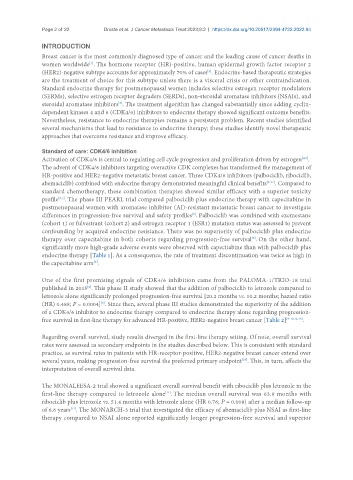Page 406 - Read Online
P. 406
Page 2 of 22 Droste et al. J Cancer Metastasis Treat 2023;9:2 https://dx.doi.org/10.20517/2394-4722.2022.94
INTRODUCTION
Breast cancer is the most commonly diagnosed type of cancer and the leading cause of cancer deaths in
[1]
women worldwide . The hormone receptor (HR)-positive, human epidermal growth factor receptor 2
(HER2)-negative subtype accounts for approximately 70% of cases . Endocrine-based therapeutic strategies
[2]
are the treatment of choice for this subtype unless there is a visceral crisis or other contraindication.
Standard endocrine therapy for postmenopausal women includes selective estrogen receptor modulators
(SERMs), selective estrogen receptor degraders (SERDs), non-steroidal aromatase inhibitors (NSAIs), and
steroidal aromatase inhibitors . The treatment algorithm has changed substantially since adding cyclin-
[3]
dependent kinases 4 and 6 (CDK4/6) inhibitors to endocrine therapy showed significant outcome benefits.
Nevertheless, resistance to endocrine therapies remains a persistent problem. Recent studies identified
several mechanisms that lead to resistance to endocrine therapy; these studies identify novel therapeutic
approaches that overcome resistance and improve efficacy.
Standard of care: CDK4/6 inhibition
Activation of CDK4/6 is central to regulating cell cycle progression and proliferation driven by estrogen .
[4,5]
The advent of CDK4/6 inhibitors targeting overactive CDK complexes has transformed the management of
HR-positive and HER2-negative metastatic breast cancer. Three CDK4/6 inhibitors (palbociclib, ribociclib,
abemaciclib) combined with endocrine therapy demonstrated meaningful clinical benefits [6-17] . Compared to
standard chemotherapy, these combination therapies showed similar efficacy with a superior toxicity
profile . The phase III PEARL trial compared palbociclib plus endocrine therapy with capecitabine in
[6,7]
postmenopausal women with aromatase inhibitor (AI)-resistant metastatic breast cancer to investigate
[6]
differences in progression-free survival and safety profiles . Palbociclib was combined with exemestane
(cohort 1) or fulvestrant (cohort 2) and estrogen receptor 1 (ESR1) mutation status was assessed to prevent
confounding by acquired endocrine resistance. There was no superiority of palbociclib plus endocrine
therapy over capecitabine in both cohorts regarding progression-free survival . On the other hand,
[6]
significantly more high-grade adverse events were observed with capecitabine than with palbociclib plus
endocrine therapy [Table 1]. As a consequence, the rate of treatment discontinuation was twice as high in
the capecitabine arm .
[6]
One of the first promising signals of CDK4/6 inhibition came from the PALOMA-1/TRIO-18 trial
published in 2015 . This phase II study showed that the addition of palbociclib to letrozole compared to
[8]
letrozole alone significantly prolonged progression-free survival [20.2 months vs. 10.2 months; hazard ratio
(HR) 0.488; P = 0.0004] . Since then, several phase III studies demonstrated the superiority of the addition
[8]
of a CDK4/6 inhibitor to endocrine therapy compared to endocrine therapy alone regarding progression-
free survival in first-line therapy for advanced HR-positive, HER2-negative breast cancer [Table 2] [8-10,12,18] .
Regarding overall survival, study results diverged in the first-line therapy setting. Of note, overall survival
rates were assessed as secondary endpoints in the studies described below. This is consistent with standard
practice, as survival rates in patients with HR-receptor-positive, HER2-negative breast cancer extend over
[19]
several years, making progression-free survival the preferred primary endpoint . This, in turn, affects the
interpretation of overall survival data.
The MONALEESA-2 trial showed a significant overall survival benefit with ribociclib plus letrozole in the
first-line therapy compared to letrozole alone . The median overall survival was 63.9 months with
[11]
ribociclib plus letrozole vs. 51.4 months with letrozole alone (HR 0.76; P = 0.008) after a median follow-up
[11]
of 6.6 years . The MONARCH-3 trial that investigated the efficacy of abemaciclib plus NSAI as first-line
therapy compared to NSAI alone reported significantly longer progression-free survival and superior

